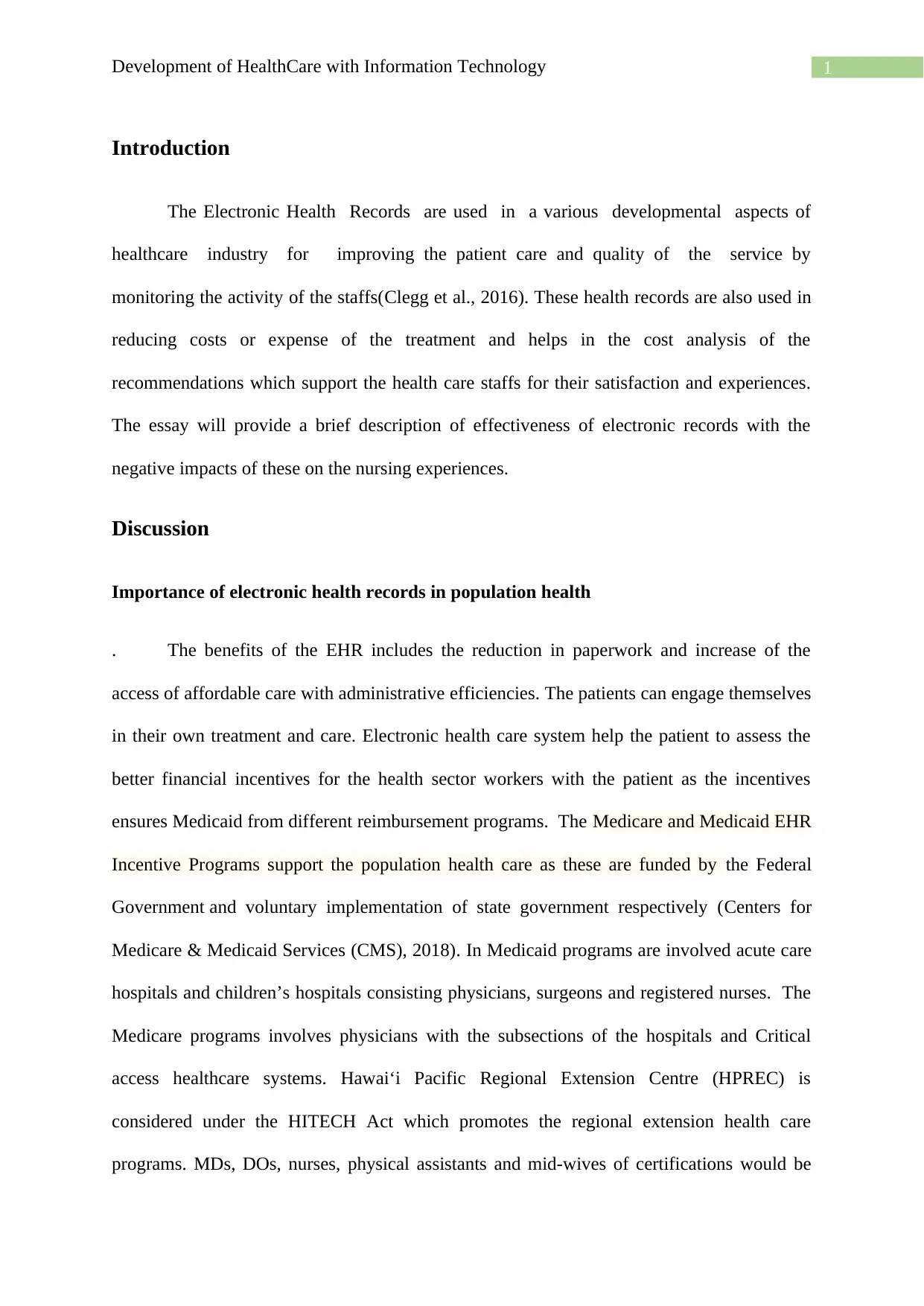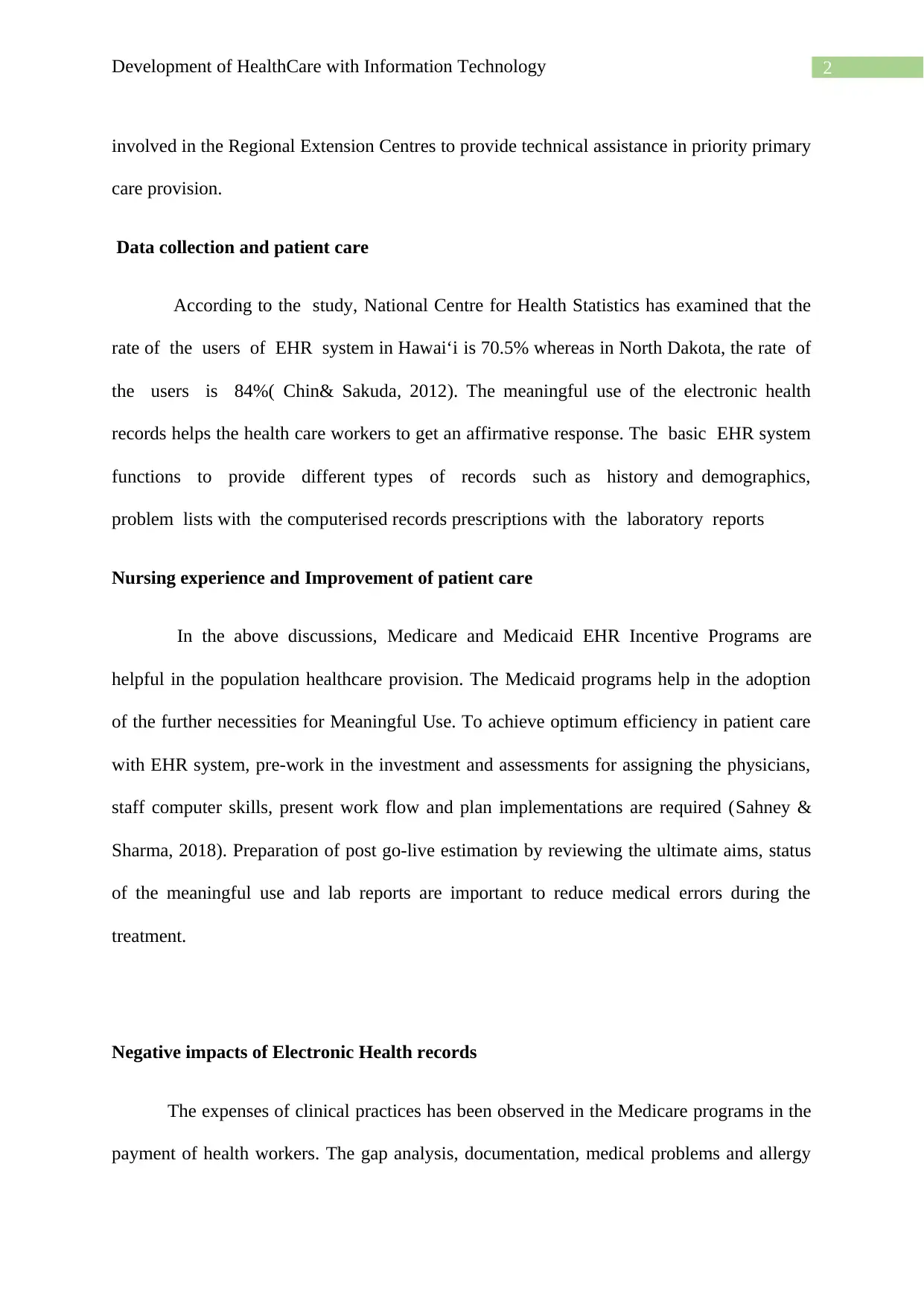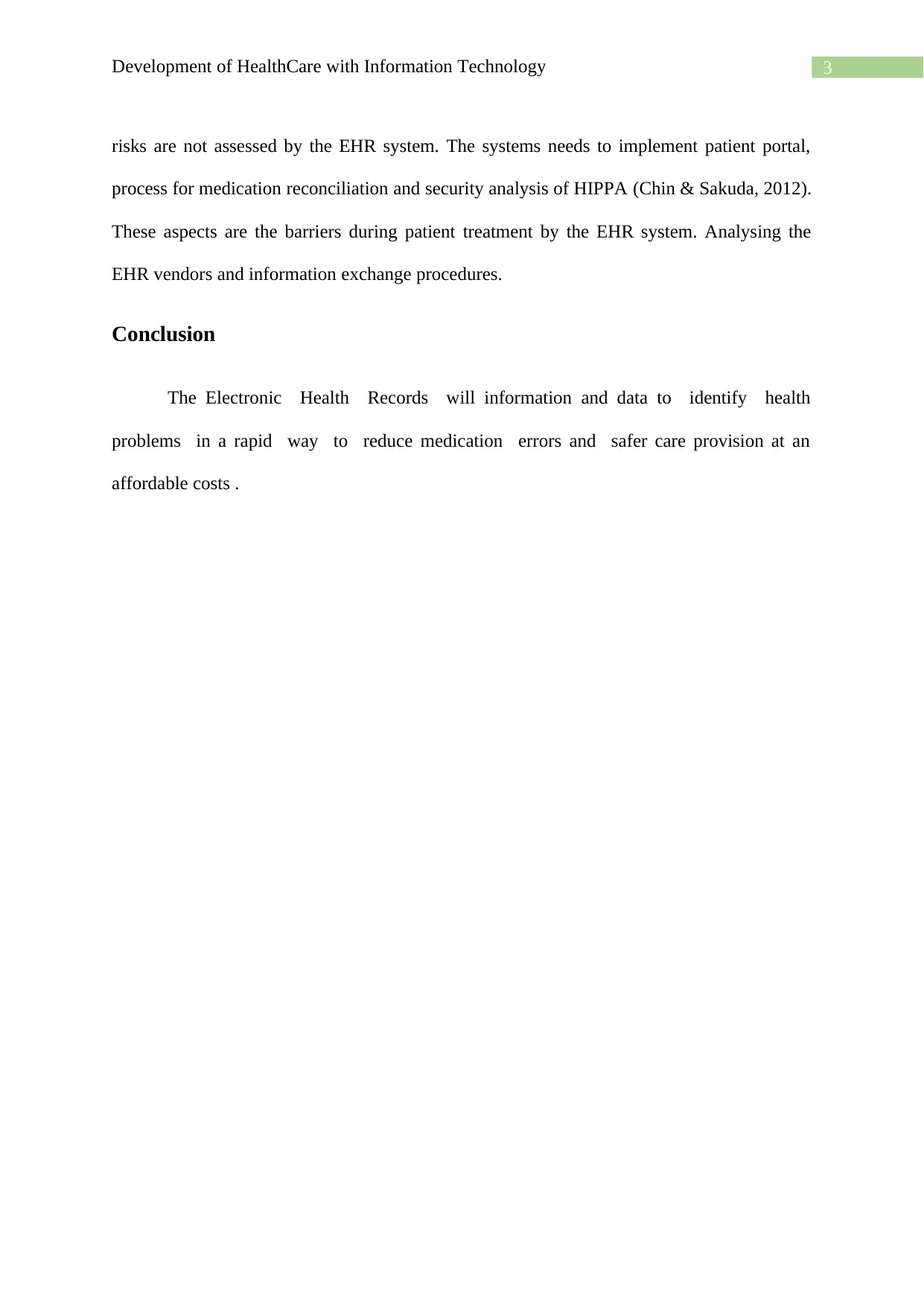University Healthcare Essay: Electronic Health Records and Nursing
VerifiedAdded on 2022/08/08
|5
|912
|15
Essay
AI Summary
This essay explores the development of healthcare through the implementation of Electronic Health Records (EHRs), focusing on their impact on population health and nursing practices. The essay examines the benefits of EHRs, such as improved patient care, reduced costs, and increased administrative efficiencies, while also addressing the negative impacts on nursing experiences. It delves into the importance of EHRs in data collection, patient care, and the role of government programs in supporting population health. The essay also reflects on nursing experiences, highlighting instances where EHRs improved patient outcomes and discussing the challenges encountered. The analysis includes references to relevant literature and government initiatives, providing a comprehensive overview of EHRs in healthcare.

Running Head: Nursing
Development of HealthCare with Information Technology
Name of the Student
Name of the University
Authors Note
Development of HealthCare with Information Technology
Name of the Student
Name of the University
Authors Note
Paraphrase This Document
Need a fresh take? Get an instant paraphrase of this document with our AI Paraphraser

1Development of HealthCare with Information Technology
Introduction
The Electronic Health Records are used in a various developmental aspects of
healthcare industry for improving the patient care and quality of the service by
monitoring the activity of the staffs(Clegg et al., 2016). These health records are also used in
reducing costs or expense of the treatment and helps in the cost analysis of the
recommendations which support the health care staffs for their satisfaction and experiences.
The essay will provide a brief description of effectiveness of electronic records with the
negative impacts of these on the nursing experiences.
Discussion
Importance of electronic health records in population health
. The benefits of the EHR includes the reduction in paperwork and increase of the
access of affordable care with administrative efficiencies. The patients can engage themselves
in their own treatment and care. Electronic health care system help the patient to assess the
better financial incentives for the health sector workers with the patient as the incentives
ensures Medicaid from different reimbursement programs. The Medicare and Medicaid EHR
Incentive Programs support the population health care as these are funded by the Federal
Government and voluntary implementation of state government respectively (Centers for
Medicare & Medicaid Services (CMS), 2018). In Medicaid programs are involved acute care
hospitals and children’s hospitals consisting physicians, surgeons and registered nurses. The
Medicare programs involves physicians with the subsections of the hospitals and Critical
access healthcare systems. Hawai‘i Pacific Regional Extension Centre (HPREC) is
considered under the HITECH Act which promotes the regional extension health care
programs. MDs, DOs, nurses, physical assistants and mid-wives of certifications would be
Introduction
The Electronic Health Records are used in a various developmental aspects of
healthcare industry for improving the patient care and quality of the service by
monitoring the activity of the staffs(Clegg et al., 2016). These health records are also used in
reducing costs or expense of the treatment and helps in the cost analysis of the
recommendations which support the health care staffs for their satisfaction and experiences.
The essay will provide a brief description of effectiveness of electronic records with the
negative impacts of these on the nursing experiences.
Discussion
Importance of electronic health records in population health
. The benefits of the EHR includes the reduction in paperwork and increase of the
access of affordable care with administrative efficiencies. The patients can engage themselves
in their own treatment and care. Electronic health care system help the patient to assess the
better financial incentives for the health sector workers with the patient as the incentives
ensures Medicaid from different reimbursement programs. The Medicare and Medicaid EHR
Incentive Programs support the population health care as these are funded by the Federal
Government and voluntary implementation of state government respectively (Centers for
Medicare & Medicaid Services (CMS), 2018). In Medicaid programs are involved acute care
hospitals and children’s hospitals consisting physicians, surgeons and registered nurses. The
Medicare programs involves physicians with the subsections of the hospitals and Critical
access healthcare systems. Hawai‘i Pacific Regional Extension Centre (HPREC) is
considered under the HITECH Act which promotes the regional extension health care
programs. MDs, DOs, nurses, physical assistants and mid-wives of certifications would be

2Development of HealthCare with Information Technology
involved in the Regional Extension Centres to provide technical assistance in priority primary
care provision.
Data collection and patient care
According to the study, National Centre for Health Statistics has examined that the
rate of the users of EHR system in Hawai‘i is 70.5% whereas in North Dakota, the rate of
the users is 84%( Chin& Sakuda, 2012). The meaningful use of the electronic health
records helps the health care workers to get an affirmative response. The basic EHR system
functions to provide different types of records such as history and demographics,
problem lists with the computerised records prescriptions with the laboratory reports
Nursing experience and Improvement of patient care
In the above discussions, Medicare and Medicaid EHR Incentive Programs are
helpful in the population healthcare provision. The Medicaid programs help in the adoption
of the further necessities for Meaningful Use. To achieve optimum efficiency in patient care
with EHR system, pre-work in the investment and assessments for assigning the physicians,
staff computer skills, present work flow and plan implementations are required (Sahney &
Sharma, 2018). Preparation of post go-live estimation by reviewing the ultimate aims, status
of the meaningful use and lab reports are important to reduce medical errors during the
treatment.
Negative impacts of Electronic Health records
The expenses of clinical practices has been observed in the Medicare programs in the
payment of health workers. The gap analysis, documentation, medical problems and allergy
involved in the Regional Extension Centres to provide technical assistance in priority primary
care provision.
Data collection and patient care
According to the study, National Centre for Health Statistics has examined that the
rate of the users of EHR system in Hawai‘i is 70.5% whereas in North Dakota, the rate of
the users is 84%( Chin& Sakuda, 2012). The meaningful use of the electronic health
records helps the health care workers to get an affirmative response. The basic EHR system
functions to provide different types of records such as history and demographics,
problem lists with the computerised records prescriptions with the laboratory reports
Nursing experience and Improvement of patient care
In the above discussions, Medicare and Medicaid EHR Incentive Programs are
helpful in the population healthcare provision. The Medicaid programs help in the adoption
of the further necessities for Meaningful Use. To achieve optimum efficiency in patient care
with EHR system, pre-work in the investment and assessments for assigning the physicians,
staff computer skills, present work flow and plan implementations are required (Sahney &
Sharma, 2018). Preparation of post go-live estimation by reviewing the ultimate aims, status
of the meaningful use and lab reports are important to reduce medical errors during the
treatment.
Negative impacts of Electronic Health records
The expenses of clinical practices has been observed in the Medicare programs in the
payment of health workers. The gap analysis, documentation, medical problems and allergy
⊘ This is a preview!⊘
Do you want full access?
Subscribe today to unlock all pages.

Trusted by 1+ million students worldwide

3Development of HealthCare with Information Technology
risks are not assessed by the EHR system. The systems needs to implement patient portal,
process for medication reconciliation and security analysis of HIPPA (Chin & Sakuda, 2012).
These aspects are the barriers during patient treatment by the EHR system. Analysing the
EHR vendors and information exchange procedures.
Conclusion
The Electronic Health Records will information and data to identify health
problems in a rapid way to reduce medication errors and safer care provision at an
affordable costs .
risks are not assessed by the EHR system. The systems needs to implement patient portal,
process for medication reconciliation and security analysis of HIPPA (Chin & Sakuda, 2012).
These aspects are the barriers during patient treatment by the EHR system. Analysing the
EHR vendors and information exchange procedures.
Conclusion
The Electronic Health Records will information and data to identify health
problems in a rapid way to reduce medication errors and safer care provision at an
affordable costs .
Paraphrase This Document
Need a fresh take? Get an instant paraphrase of this document with our AI Paraphraser

4Development of HealthCare with Information Technology
References
Centers for Medicare & Medicaid Services (CMS), HHS. (2018). Medicare Program;
Hospital Inpatient Prospective Payment Systems for Acute Care Hospitals and the
Long-Term Care Hospital Prospective Payment System and Policy Changes and
Fiscal Year 2019 Rates; Quality Reporting Requirements for Specific Providers;
Medicare and Medicaid Electronic Health Record (EHR) Incentive Programs
(Promoting Interoperability Programs) Requirements for Eligible Hospitals, Critical
Access Hospitals, and Eligible Professionals; Medicare Cost Reporting Requirements;
and Physician .... Federal register, 83(160), 41144.
Chin, B. J., & Sakuda, C. M. I. (2012). Transforming and improving health care through
meaningful use of health information technology. Hawai'i Journal of Medicine &
Public Health, 71(4 Suppl 1), 50.
Clegg, A., Bates, C., Young, J., Ryan, R., Nichols, L., Ann Teale, E., ... & Marshall, T.
(2016). Development and validation of an electronic frailty index using routine
primary care electronic health record data. Age and ageing, 45(3), 353-360.
Sahney, R., & Sharma, M. (2018). Electronic health records: A general overview. Current
Medicine Research and Practice, 8(2), 67-70.
References
Centers for Medicare & Medicaid Services (CMS), HHS. (2018). Medicare Program;
Hospital Inpatient Prospective Payment Systems for Acute Care Hospitals and the
Long-Term Care Hospital Prospective Payment System and Policy Changes and
Fiscal Year 2019 Rates; Quality Reporting Requirements for Specific Providers;
Medicare and Medicaid Electronic Health Record (EHR) Incentive Programs
(Promoting Interoperability Programs) Requirements for Eligible Hospitals, Critical
Access Hospitals, and Eligible Professionals; Medicare Cost Reporting Requirements;
and Physician .... Federal register, 83(160), 41144.
Chin, B. J., & Sakuda, C. M. I. (2012). Transforming and improving health care through
meaningful use of health information technology. Hawai'i Journal of Medicine &
Public Health, 71(4 Suppl 1), 50.
Clegg, A., Bates, C., Young, J., Ryan, R., Nichols, L., Ann Teale, E., ... & Marshall, T.
(2016). Development and validation of an electronic frailty index using routine
primary care electronic health record data. Age and ageing, 45(3), 353-360.
Sahney, R., & Sharma, M. (2018). Electronic health records: A general overview. Current
Medicine Research and Practice, 8(2), 67-70.
1 out of 5
Related Documents
Your All-in-One AI-Powered Toolkit for Academic Success.
+13062052269
info@desklib.com
Available 24*7 on WhatsApp / Email
![[object Object]](/_next/static/media/star-bottom.7253800d.svg)
Unlock your academic potential
Copyright © 2020–2025 A2Z Services. All Rights Reserved. Developed and managed by ZUCOL.




